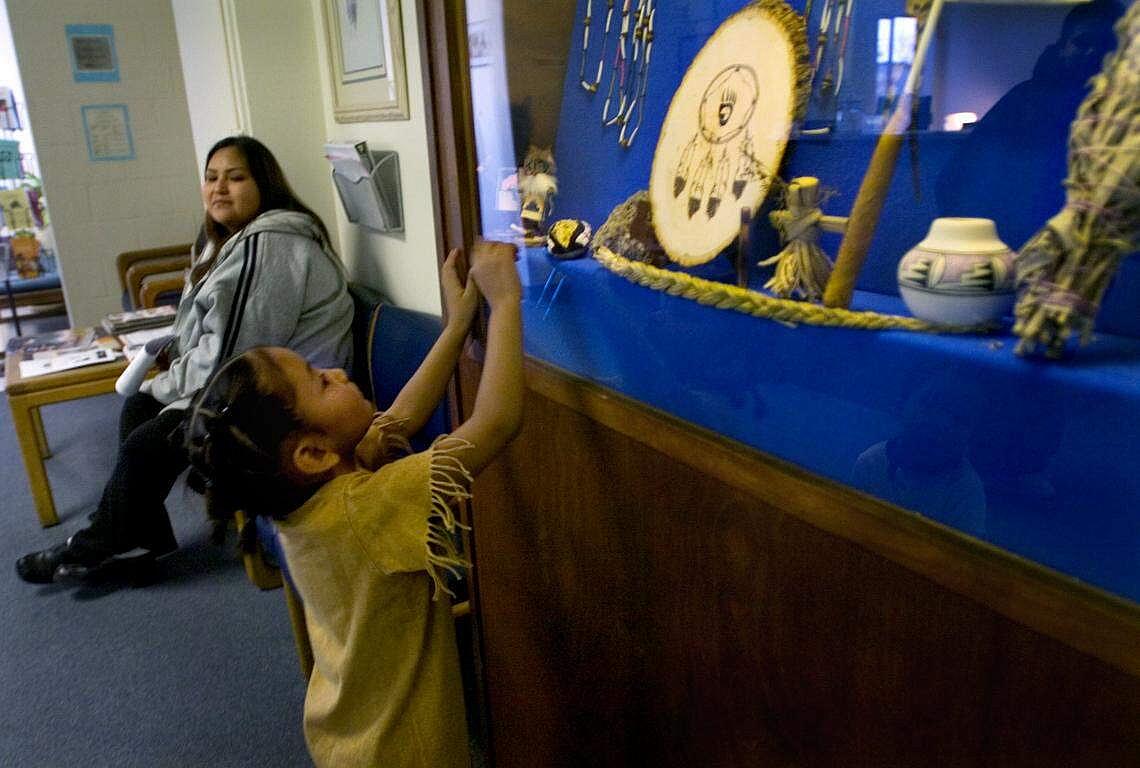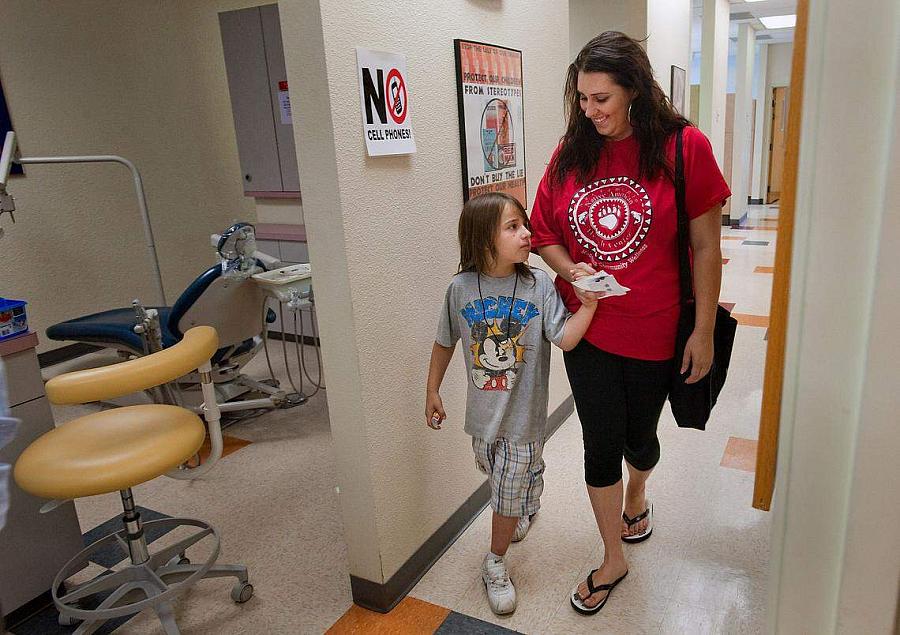How culture saves Sacramento’s Native American youth from suicide
The story was originally published by the The Sacramento Bee with support from our 2025 California Health Equity Fellowship

Alyssa Ringlero, 4, peers into a display case of Native American cultural items while waiting with mom, Dianna Ringlero, in a patient waiting area inside the Sacramento Native American Health Center in 2007.
Lezlie Sterling Sacramento Bee file
Jordan Burkart learned pain at a young age. She was placed in foster care at just three days old after Child Protective Services learned her parents were using drugs, she said. Though she was later adopted, she boomeranged between her birth and adoptive parents during her early childhood.
Life was especially chaotic with her biological parents. Burkart, now 22 and an incoming senior at Sacramento State, recalled that they used to steal her shoes and hang them over electrical wires signaling to a dealer that they wanted to buy drugs. She didn’t feel safe.
Burkart said she started feeling depressed and anxious in social situations as a preteen. At her lowest points in high school, she admitted she had suicidal thoughts.
“I felt like nobody loved me,” Burkart said. “I just felt like I was not good enough.”
Mental health challenges and suicide disproportionately affect Native communities nationwide, and the problem is particularly acute among young people. In 2022, suicide was the second leading cause of death of American Indian and Alaska Native young people ages 10 to 34, behind unintentional injury, according to the U.S. Department of Health and Human Services Office of Minority Health.
In California, Native youth ages 10 to 25 experienced the highest suicide rate from 2016 to 2021, according to the state Department of Public Health, despite making up the smallest ethnic demographic.
State Assemblymember James Ramos, D-San Bernardino, said many programs to address Native people’s mental health haven’t succeeded because they haven’t included cultural practices.
“There’s a crisis going on with suicide and mental health in Indian Country,” said Ramos, the first Native American in the California Legislature. “The voices should come from the people themselves.”
The reasons are complex, according to tribal leaders, Native American advocacy groups, mental health experts, and Native youths themselves. They cite intergenerational trauma stemming from the colonization of America, which led to genocide, forced assimilation, and the loss of identity and cultural practices.
As a result of these traumas, compounded over centuries, Native people are more likely to face systemic barriers that affect mental health and access to treatment, like poverty, inadequate economic opportunities, and lack of health insurance, according to Mental Health America.
“In almost every generation, we’re fighting harder for identity, even though it feels like more kids are open and exposed to culture than ever before,” said Albert Titman, the director of Native Dads Network, an Indigenous nonprofit.
Experts fear Indian Country’s mental health crisis could get worse as the Trump administration cuts hundreds of billions of dollars from programs such as Medicaid and the already under-funded federal Indian Health Service, including its network of health facilities and clinics. These cutbacks mean “lives are at risk,” said Virginia Hedrick, executive director of the California Consortium for Urban Indian Health, in a July 3 press release.
Access to effective care has been a persistent problem for Burkart.
Before college, Burkart went to multiple therapists but was put off by their lack of cultural understanding, she said. Her first therapist had a dog bed that looked like a tepee in the waiting room. The next one was French. “It was different cultures and completely different understandings,” she said.
At Sacramento State, she has access to free counseling appointments, but the counselors she saw were white. She said she didn’t feel a connection.
Local resources
Members of the Sacramento area’s Native American community represent a blend of local tribal nations and others across the county. More than 45,000 American Indians and Alaska Natives live in the six-county region, including members of Wilton Rancheria, the only federally recognized tribe in Sacramento County, and Shingle Springs, the only federally recognized tribal nation in El Dorado County.
Because of the diverse population, there is no cookie-cutter way to treat Native communities, Titman said. The stigma of mental illness and the community’s distrust of Western medicine further limit treatment options, he said.
“With multi-generational trauma, there are trust issues,” Titman said. “Our people still don’t trust going to visit a non-Native doctor, psychiatrist or therapist.”
Shingle Springs’ Health and Wellness Center, which is open to both tribal citizens and other Native people, has 40,000 visits a year and 8,000 consistent patients, said Kyle Nelson, the center’s executive director. Wilton Rancheria is creating a wellness program and center, funded in part by gaming revenue, said Titman, who assists the tribe.
The city of Sacramento is home to the Sacramento Native American Health Center, an urban health clinic funded partly by the federal Indian Health Service. It offers services rooted in Indigenous culture and knowledge, including a program called “culture is prevention,” said CEO Britta Guerrero, a citizen of the San Carlos Apache tribe.
The clinic integrates traditional healing into its mental health and substance abuse therapies, including suicide prevention. For instance, it offers classes on making ribbon skirts and bone bead necklaces, which provide a way to reconnect with cultural roots, said Johnny Lopez, the center’s communications manager.
For Native youth, connecting to culture cultivates a sense of purpose, and the feeling that they’re an extension of their ancestors’ strength and perseverance, he said.
“We’re preserving culture through all these different classes, because they’re all from very different backgrounds,” Lopez said.
Culturally relevant care was hard to find for Haiwee Fredericks, 21, who studies sustainable agriculture and Native American studies at the University of California, Davis. Fredericks, who is Paiute, Shoshone, and Washoe, struggled when she started college with an undiagnosed learning disability, which made her emotionally overwhelmed and anxious, she said. She didn’t leave her room for weeks at a time. Her grades suffered. She grew homesick.
When she met with a psychiatrist, she said she described her spiritual beliefs associated with her Indigenous background. In response, she said, the clinician said she may have schizophrenia.
“They just wouldn’t fully comprehend ceremonies and more of the spiritual aspect” of Native culture, Fredericks said. “I wanted to talk to someone who was at least within the Native community and had more of an understanding.”
She then sought help from the Sacramento Native American Health Center, and said she immediately felt comfortable when she saw the center decorated with basketry and photos of Native people. A psychiatrist there diagnosed her with attention deficit disorder, which aligned with Fredericks’ experience. Since going on medication, she said her mental health and studies have become more manageable.
“Things have been much better,” Fredericks said. “I have the energy and motivation to get out of bed.”
A Perilous Future
Funding for urban Indian Health Organizations in California, like the Sacramento Native American Health Center, hangs in the balance.
The recently passed federal budget reconciliation bill makes cuts to health care programs that Indigenous people rely on, including Medicaid. About 70% of tribal health organizations’ revenue comes from Medicaid, based on a report from the U.S. Department of Health and Human Services. And at least 1 million American Indians and Alaska Natives nationwide are covered by Medicaid, according to the National Council of Urban Indian Health.

Dental patient Michael Hunsaker 7, left, and his mother Emma Snuggs (cq) at the Sacramento Native American Health Center, Inc. in Sacramento in June 2010.
Randall Benton Sacramento Bee file
“The thought of losing funding for any reason or the destabilizing of any program causes our folks to be troubled,” Guerrero said. She said Indian health clinics are already “drastically underfunded.”
Most of the patients at Shingle Springs’ health center are covered by Medi-Cal, California’s Medicaid program, Nelson said. The cuts will affect patients’ ability to access services, he said, and also the center’s ability to offer and expand services.
“If there’s less visits and less people who can access these services, that changes the ability to continue to fund all of the services and all the agencies,” Nelson said.
But Titman said he remains hopeful, because Native communities can seek treatment through culture, which doesn’t rely on Medicaid or other federal programs. There’s power in reclaiming traditions that were once stolen from Native people, he explained.
Culture is medicine, he said.
Using culture as a means to treat Native patients has been embraced as a way to reconcile and heal from historic traumas, according to the American Psychological Association. The association recommended the integration of Indigenous cultural practices to care for Native patients. In this statement, the group also apologized for a history of “destructive harms and forced actions” psychology has inflicted on Indigenous people, like sterilization, relocation, and the removal of Native children from their families.
Over time, Burkart has gravitated to an “unspoken therapy” including Native traditions, such as hand games, an Indigenous game in which a team hides sticks or other objects in their hands while the other team tries to guess their location. Back in middle school, she played hand games with her Native friends once a week, which made her feel more secure and accepted.
Burkart continues to be active in other Native events, even ones that aren’t geared toward mental health, such as the Native Vote Project and Honor Elders Day, and has found a sense of belonging at each one.
“Just being around other Native people, even if they’re not from my tribe, is still helpful to me,” Burkart said. “I feel like I was useful to my community, because I’m doing something to help people.”
Burkart agrees that cultural practices can have more impact than Western medicine. When she faced challenges and bullying in middle school, playing hand games with her Native friends kept her going. When she felt alone as a young adult, the Sierra College Big Time/Powwow made her feel at home. When she needed a role model to guide her, her Native elders taught her how to persevere, she explained.
“A lot of times, culture and mental health, you can’t really separate the two,” Burkart said.
“Especially living in today,” she added, “how are you gonna have good mental health if you don’t have a community and culture? I feel like it’s imperative.”

